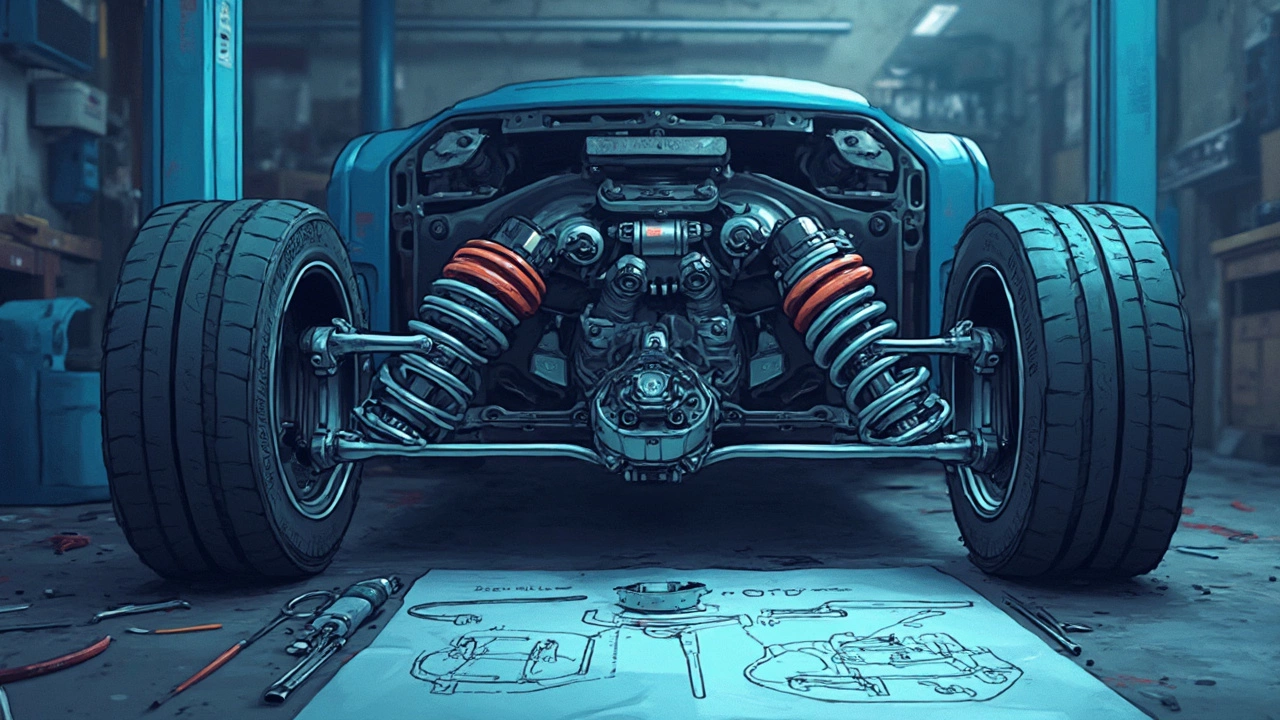So, you're thinking about using lowering springs with your car's stock shocks? It's a pretty common idea among car enthusiasts looking to give their ride a sportier look without breaking the bank. But should you go for it?
First, let’s understand what lowering springs do. They reduce your car's ride height, giving it a sleeker, more aggressive stance. That sounds great, right? But here’s the catch: when you lower the ride height, you're also changing how your car handles and how it feels when you're driving.
Now, about those stock shocks—they’re designed to work with the original height of your car. When you swap out your regular springs for lowering ones, the stock shocks can struggle. They're not made for that reduced height, which can lead to less-than-ideal performance. Some folks report a bouncier ride or even quicker wear and tear on their shocks.
Of course, it’s not all doom and gloom. Plenty of car owners do use lowering springs without immediate problems. The key is knowing what to expect and weighing the pros and cons.
- Understanding Lowering Springs
- Compatibility with Stock Shocks
- Potential Impacts on Ride Quality
- Cost and Practical Considerations
- Tips for Safe Installation
Understanding Lowering Springs
Thinking about giving your car that sleek, low-profile look? Let's dive into the world of lowering springs. They're designed to drop your ride height, which doesn't just make your car look cool, but can also enhance handling by lowering the car's center of gravity.
The basic idea behind lowering springs is pretty straightforward. By shortening the spring, you can reduce the distance between the car's body and its wheels. But it's more than just aesthetics. A lower ride height means less air going under the vehicle, which can help with aerodynamics. This might improve handling at higher speeds and reduce body roll when taking corners.
How Do Lowering Springs Work?
Lowering springs are typically stiffer than standard springs, which means they compress less under load. This change in stiffness can improve responsiveness when you're steering because the car's body doesn't shift as much. However, the trade-off can be a firmer ride—something to keep in mind if your car's also your daily driver.
Benefits of Lowering Springs
- Improved aesthetics with a lower ride height
- Enhanced handling and cornering by lowering the center of gravity
- Potentially better aerodynamics leading to less drag
These springs are ideal for those who want performance on a budget. But remember, they're one part of a bigger suspension picture. Pairing them with stock shocks means you might not get the full benefits or could wear out those shocks faster than you'd like.
Before you jump in, consider your car's purpose. If it's mostly for getting around town, the softer springs might suit your lifestyle better. But if you love the idea of sharp cornering and a bold stance, lowering springs might just be what you're looking for.
Compatibility with Stock Shocks
Let's get into whether you can really mix lowering springs with stock shocks. It's kind of like trying to wear sneakers with a tuxedo—sometimes it works, sometimes it doesn't.
Stock shocks are built to handle a specific range of motion, and that range aligns with your car’s original ride height. When you put in lowering springs, you're essentially forcing those shocks to operate outside their comfort zone. This can affect how well they absorb road impacts.
What does that mean for your daily drive? You might feel every bump in the road more sharply, and the ride can get bouncy. It's not ideal for long-term comfort or performance. This is especially the case if you drop your ride more than just an inch or so.
Effects on Shock Longevity
Another thing to consider is wear and tear. Stock shocks aren't made to handle the compressed state that lowering springs put them in. Over time, this can lead to premature shock failure. Imagine your shocks giving up on you halfway through their expected lifespan—it's both inconvenient and costly.
What's the Solution?
- Limited Drop: Keep the drop moderate, ideally under about 1.5 inches, to reduce stress on the stock shocks.
- Performance Shocks: For the best results, pair lowering springs with performance shocks designed to handle the reduced height.
While you might get away with this compromise for a while, keep an eye on your ride's handling. If things start to feel off, it might be time to consider a full suspension upgrade.

Potential Impacts on Ride Quality
When you drop your car closer to the ground using lowering springs, you can't ignore how it affects the ride quality. This change can be a game-changer, especially if you're used to the smooth experience that stock shocks usually provide.
Stiffness and Comfort
One of the most noticeable changes is in the suspension's stiffness. Lowering springs are stiffer than regular ones because they’re designed to minimize body roll and improve handling. However, with stock shocks, you might find the ride to be harsher or stiffer. It could get uncomfortable on rough roads or long drives since the shocks aren’t optimized for the new spring rate.
Handling and Performance
On the flip side, a lowered car generally corners better and feels more stable at higher speeds because of the lower center of gravity. The trade-off, though, is that without performance shocks, that improved handling might not be as pronounced as you'd hope. Your suspension setup might not effectively absorb bumps, affecting overall control.
Lifespan of Stock Shocks
How long will your stock shocks last with lowering springs? It's a bit of a gamble. Since the shocks aren't built to handle the reduced height and increased stiffness, they might wear out quicker. You may experience things like leakages or reduced damping capability over time.
Before You Decide
- Consider how you use your car daily. Do you often drive on uneven roads?
- Assess whether the improved performance in handling outweighs the potential decrease in comfort.
- Think about your budget. If the stock shocks wear out, are you ready to upgrade to performance shocks?
While many enjoy the aesthetic and handling boost from lowering, it’s crucial to weigh these impacts on ride quality before pulling the trigger. Understanding these factors helps avoid unwanted surprises down the road.
Cost and Practical Considerations
Thinking about the financial side of adding lowering springs to your car? You're not alone. This decision quite often comes down to balancing your budget with your desire for a cooler looking ride. Like most mods, there are a few things to weigh up here.
Initial Costs
First off, let's talk upfront costs. Lowering springs themselves aren't too pricey; you can usually snag a set for somewhere between $100 to $300, depending on brand and quality. But remember, you're also paying for installation unless you’re DIY-ing. Professional installation can run you another $100 to $300. So, factor in about $200 to $600 all in.
Potential Additional Expenses
Here’s where things get interesting. Some folks might tell you to bump up your budget for future expenses. Why? Stock shocks aren’t meant for lower heights, which could cause premature wear. If those shocks tap out sooner, you'll need replacements, which could set you back $150 to $500.
Long-term Considerations
Don't forget about your car’s ride quality and handling—there’s a fine line between driving enjoyment and headache. If the ride’s too rough, or the handling gets wonky, you might end up modifying other parts of your suspension, which means even more dollars spent.
Wise Tips
If you're set on car modification with stock shocks, keep tabs on how your car feels. Notice any weird noises or a bouncier ride? It could be a sign to beef up your suspension.
Remember, with every mod usually comes some level of compromise between cost, performance, and comfort. The real trick is to make sure you're prepared—and your wallet is ready for whatever comes next.

Tips for Safe Installation
Installing lowering springs is a popular car mod, but doing it right is crucial to avoid headaches later. Here's a straightforward guide to help you out.
Avoid Rushing the Process
First things first, this isn't a race. Take your time to understand the process. Double-check everything before you remove any parts. Make sure you have the right tools ready.
Get All the Right Gear
Before starting, gather all necessary tools and safety equipment. You'll need a spring compressor, jack stands, and basic hand tools like wrenches and sockets. Having the right gear can save a lot of hassle and keep things safe.
Check the Compatibility
Stock shocks are not always ideal for lowering springs. If they’re not compatible, you might face more than just some noise; it could affect your vehicle’s handling. Do your research on your car model and the specific lowering springs you choose.
Follow Best Practices
- Unplug the Battery: Safety first—always disconnect the battery to prevent any electrical mishaps.
- Secure the Vehicle: Use jack stands to keep the car stable. Safety should always be your top priority.
- Use Spring Compressors: To safely remove the old springs, use spring compressors. Never attempt to remove springs without one.
- Double-Check Alignments: Once installed, ensure everything is aligned and tightened properly. Misalignments can lead to uneven wear and tear.
Consider Getting a Professional Alignment
After installing your lowering springs, it’s wise to get a professional alignment. Even slight misalignment can lead to bigger issues down the road.
Test Drive and Adjust
Finally, take your car for a gentle test drive. Listen for unusual sounds and feel out any handling quirks. Don’t ignore any issues; address them immediately to ensure a smooth ride.




